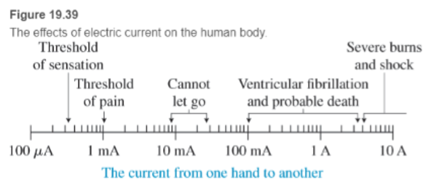
BIO Effect of
A potential difference across two parts of the body (for example, the 120-V potential difference from a wall socket from one hand to the other or from the hands to the feet) can initiate an electric current in the body that stimulates nerve endings and triggers nerve signals that cause muscular contraction. Even worse, the current in the body can upset the rhythmic electrical operation of the heart. The heart muscles might be stimulated randomly in what is called ventricular fibrillation—a random contraction of the ventricles, which can be deadly. A rough guide to the effects of electric current on the body at different current levels is provided in Figure 19.39. Under dry conditions, human skin has high electrical resistance. Wet skin dramatically lowers the body’s resistance and makes electrocution more likely to occur.

Suppose the electrical resistance across your wet skin is about 1000 Ω. Which answer below is closest to the least potential difference from one hand that will cause slight pain?
a. 0.1 V
b. 1 V
c. 10 V
d. 100 V
e. 1000 V
Want to see the full answer?
Check out a sample textbook solution
Chapter 19 Solutions
College Physics
Additional Science Textbook Solutions
Organic Chemistry (8th Edition)
Microbiology with Diseases by Body System (5th Edition)
Anatomy & Physiology (6th Edition)
Applications and Investigations in Earth Science (9th Edition)
Human Anatomy & Physiology (2nd Edition)
Campbell Biology (11th Edition)
- Find the total capacitance in micro farads of the combination of capacitors shown in the figure below. HF 5.0 µF 3.5 µF №8.0 μLE 1.5 µF Ι 0.75 μF 15 μFarrow_forwardthe answer is not 0.39 or 0.386arrow_forwardFind the total capacitance in micro farads of the combination of capacitors shown in the figure below. 2.01 0.30 µF 2.5 µF 10 μF × HFarrow_forward
- I do not understand the process to answer the second part of question b. Please help me understand how to get there!arrow_forwardRank the six combinations of electric charges on the basis of the electric force acting on 91. Define forces pointing to the right as positive and forces pointing to the left as negative. Rank in increasing order by placing the most negative on the left and the most positive on the right. To rank items as equivalent, overlap them. ▸ View Available Hint(s) [most negative 91 = +1nC 92 = +1nC 91 = -1nC 93 = +1nC 92- +1nC 93 = +1nC -1nC 92- -1nC 93- -1nC 91= +1nC 92 = +1nC 93=-1nC 91 +1nC 92=-1nC 93=-1nC 91 = +1nC 2 = −1nC 93 = +1nC The correct ranking cannot be determined. Reset Help most positivearrow_forwardPart A Find the x-component of the electric field at the origin, point O. Express your answer in newtons per coulomb to three significant figures, keeping in mind that an x component that points to the right is positive. ▸ View Available Hint(s) Eoz = Η ΑΣΦ ? N/C Submit Part B Now, assume that charge q2 is negative; q2 = -6 nC, as shown in (Figure 2). What is the x-component of the net electric field at the origin, point O? Express your answer in newtons per coulomb to three significant figures, keeping in mind that an x component that points to the right is positive. ▸ View Available Hint(s) Eoz= Η ΑΣΦ ? N/Carrow_forward
- 1. A charge of -25 μC is distributed uniformly throughout a spherical volume of radius 11.5 cm. Determine the electric field due to this charge at a distance of (a) 2 cm, (b) 4.6 cm, and (c) 25 cm from the center of the sphere. (a) = = (b) E = (c)Ẻ = = NC NC NCarrow_forward1. A long silver rod of radius 3.5 cm has a charge of -3.9 ис on its surface. Here ŕ is a unit vector ст directed perpendicularly away from the axis of the rod as shown in the figure. (a) Find the electric field at a point 5 cm from the center of the rod (an outside point). E = N C (b) Find the electric field at a point 1.8 cm from the center of the rod (an inside point) E=0 Think & Prepare N C 1. Is there a symmetry in the charge distribution? What kind of symmetry? 2. The problem gives the charge per unit length 1. How do you figure out the surface charge density σ from a?arrow_forward1. Determine the electric flux through each surface whose cross-section is shown below. 55 S₂ -29 S5 SA S3 + 9 Enter your answer in terms of q and ε Φ (a) s₁ (b) s₂ = -29 (C) Φ զ Ερ (d) SA = (e) $5 (f) Sa $6 = II ✓ -29 S6 +39arrow_forward

 College PhysicsPhysicsISBN:9781938168000Author:Paul Peter Urone, Roger HinrichsPublisher:OpenStax College
College PhysicsPhysicsISBN:9781938168000Author:Paul Peter Urone, Roger HinrichsPublisher:OpenStax College Physics for Scientists and Engineers, Technology ...PhysicsISBN:9781305116399Author:Raymond A. Serway, John W. JewettPublisher:Cengage Learning
Physics for Scientists and Engineers, Technology ...PhysicsISBN:9781305116399Author:Raymond A. Serway, John W. JewettPublisher:Cengage Learning Principles of Physics: A Calculus-Based TextPhysicsISBN:9781133104261Author:Raymond A. Serway, John W. JewettPublisher:Cengage Learning
Principles of Physics: A Calculus-Based TextPhysicsISBN:9781133104261Author:Raymond A. Serway, John W. JewettPublisher:Cengage Learning College PhysicsPhysicsISBN:9781305952300Author:Raymond A. Serway, Chris VuillePublisher:Cengage Learning
College PhysicsPhysicsISBN:9781305952300Author:Raymond A. Serway, Chris VuillePublisher:Cengage Learning Physics for Scientists and EngineersPhysicsISBN:9781337553278Author:Raymond A. Serway, John W. JewettPublisher:Cengage Learning
Physics for Scientists and EngineersPhysicsISBN:9781337553278Author:Raymond A. Serway, John W. JewettPublisher:Cengage Learning





